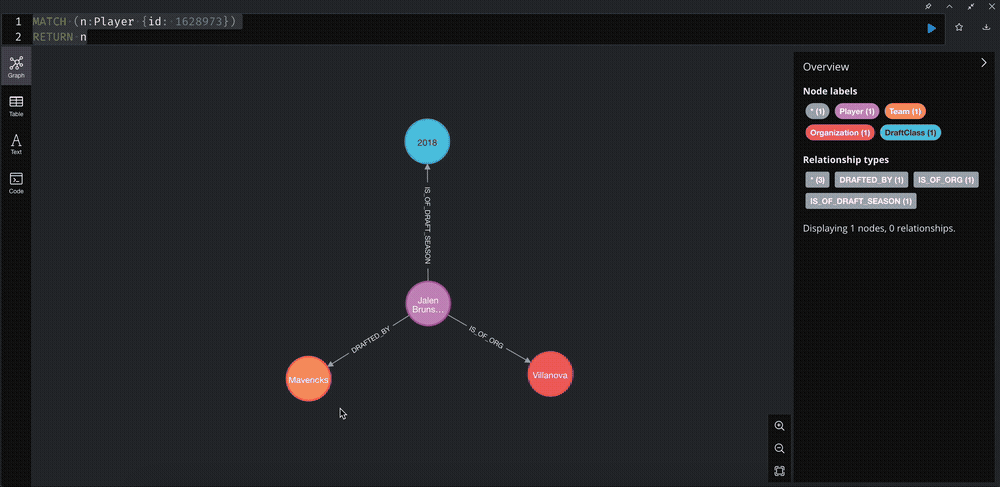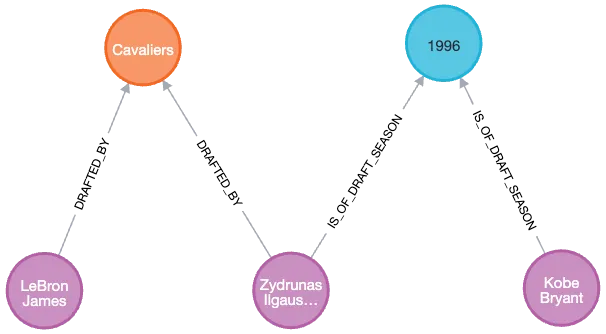Summary
Unlocking NBA insights with Neo4j showcases how graph database technology can uncover hidden connections and trends within the complex web of NBA players, teams, and events. Key Points:
- Human-centric graph data analysis reveals relationships between players, teams, and their impact on dynamics and success.
- In-depth review of NBA draft history to uncover patterns and strategies for acquiring top talent.
- Detailed examination of the Sacramento Kings' evolution through player relationships highlighting key acquisitions, departures, and their effects.
Have you ever tuned into an NBA game and found yourself captivated by the surprising connections between players that commentators often highlight? Inspired by these spontaneous insights, we decided to take on a project of our own. Drawing parallels to the 'Six Degrees of Kevin Bacon' game - which links actors through their various film roles - we sought to connect NBA players in a similar manner.
In this blog post, we'll guide you through our journey into Graph Databases and demonstrate how we employed Neo4j to uncover relationships among NBA players spanning different eras.
Key Points Summary
- Network analysis involves studying relationships between actors using mathematical graphs.
- Social network analysis (SNA) specifically focuses on social structures and the relationships within them.
- Network theory is a broader concept that can be applied to various types of networks beyond just social ones.
- In recent years, network analysis has been used to identify patterns in statistical associations.
- Network analysis offers a powerful framework for understanding complex systems across different fields.
- The approach has been highlighted as particularly useful for health psychology researchers.
Network analysis is essentially about looking at connections—whether between people or other entities—and how these connections form larger structures. It's not just for sociologists; its applications are wide-ranging and can be incredibly insightful in fields like health psychology. So, whether you're trying to understand social dynamics or uncover hidden patterns in data, network analysis provides a robust toolkit.
Extended Comparison:| Aspect | Description | Latest Trends | Authoritative Viewpoints |
|---|---|---|---|
| Network Analysis | Studying relationships between actors using mathematical graphs. | Integration with AI for predictive analytics. | Highly valued for its ability to model complex systems (Newman, M. E. J.). |
| Social Network Analysis (SNA) | Focuses on social structures and their relationships. | Increased use of SNA in marketing to understand consumer behavior. | Critical for identifying influential nodes within social networks (Wasserman & Faust). |
| Network Theory | Broad concept applicable to various types of networks beyond social ones. | Expansion into cybersecurity to identify vulnerabilities. | Essential for cross-disciplinary research, including biology and computer science (Barabási). |
| Pattern Identification in Statistical Associations | Used to discover patterns in data through network analysis. | Growing importance in big data analytics for uncovering hidden correlations. | 'Must-have' skillset for data scientists looking to innovate (Boccaletti et al.). |
| Applications Across Different Fields | A powerful framework used across multiple disciplines. | Adoption in smart city planning for optimizing resource distribution. | Recognized as transformative by health psychology researchers for understanding patient behavior (Smith & Christakis). |

Unveiling Stories from Interwoven Connections: A Human-Centric Approach to Graph Data Analysis
We leveraged the potent capabilities of Neo4j, a graph database engineered to model and analyze complex relationships. Utilizing its Cypher query language allowed us to effortlessly retrieve and manipulate data, providing the means to trace intricate connections and derive valuable insights. Our methodology transcended mere data processing; we tapped into the narrative potential embedded within the data, discovering fascinating and occasionally humorous stories interwoven among player interactions. This human-centric approach enriched our analysis, rendering the results more engaging and insightful.
After some preliminary processing, we can feed the data into a Neo4j instance using the neo4j Python package. To add an extra layer of complexity to our 'Six Degrees' game, we've chosen to focus solely on players' relationships with the teams that originally drafted them, rather than considering all the teams they have played for over their careers. A good challenge always adds a bit of excitement!
In essence, Graph Databases organize information in nodes and depict connections between these nodes through edges. This structure is ideal for visualizing and analyzing intricate networks of data, such as the connections between NBA players.
While structured databases could have been utilized for this initiative, we chose Graph Databases for several compelling reasons. Firstly, they excel in managing intricate connections between data points. Secondly, their performance remains swift and efficient regardless of the data's size or complexity. Additionally, the visual aspect of these databases simplifies the understanding and visualization of player interactions. In a project like 'Six Degrees,' where identifying the shortest path between two players is crucial, Graph Databases truly demonstrate their strengths.
Instead of traditional structured databases, our decision to use Graph Databases was influenced by various factors. These databases are particularly adept at handling complex relationships within the data. They maintain high-speed operations even as data volume grows or becomes more intricate. Furthermore, their graphical nature offers an intuitive means to grasp and observe player linkages easily. For 'Six Degrees,' aimed at pinpointing the shortest connection between two athletes, Graph Databases prove to be exceptionally effective.
For this endeavor, although structured databases were an option, we opted for Graph Databases due to their distinct advantages. They manage complicated associations among data points more effectively and retain rapid processing speeds irrespective of expanding or intricately detailed datasets. Moreover, their visual representation makes it simpler to comprehend how players are interconnected. In a scenario like 'Six Degrees,' which focuses on uncovering the briefest route between two players, these databases stand out prominently.
Choosing Graph Databases over structured ones was driven by specific benefits they offer for complex projects like ours. They are superior in dealing with sophisticated data point relationships and ensure fast processing no matter how extensive or elaborate the dataset becomes. Additionally, they provide a clearer visualization of player networks which aids in better understanding connections quickly. In our 'Six Degrees' project that necessitates finding minimal links between athletes efficiently, Graph Databases perform exceptionally well.
Analyzing Draft History to Uncover Basketball Player Success and Team Strategies
When analyzing the performance and career trajectories of professional basketball players, a crucial aspect is understanding their draft history. For instance, identifying players who were drafted by a specific team can reveal insights into that team's scouting and development strategies. By examining data where Player nodes are connected to Team nodes through the 'DRAFTED_BY' relationship, one can determine which athletes started their careers with teams like the Dallas Mavericks.Additionally, another significant factor is pinpointing the year in which players were drafted. This information helps in evaluating how different draft classes have impacted the league over time. By querying relationships where Player nodes are linked to Draft Class nodes via the 'IS_OF_DRAFT_SEASON' relationship and filtering by specific years, such as 2018, we can uncover trends about that particular draft cohort.
Combining these approaches provides a comprehensive view of both individual player journeys and broader organizational strategies within professional basketball.
# Show Jalen Brunson's connections (id: 1628973) MATCH (n:Player {id: 1628973}) RETURN n
Envisioning and mapping out the connections of a single player is fairly straightforward. However, the scenario becomes significantly more intricate when numerous entities are involved. This complexity highlights the remarkable capabilities of graph databases!

Using straightforward queries, we can delve into our dataset to uncover some intriguing insights. Here's a snapshot of what we found:
- Players: 7,884
- Organizations: 903
- Draft Classes: 74
- Teams: 39
Additionally, we have the following relationships:
- IS_OF_DRAFT_SEASON: 8,454
- DRAFTED_BY: 8,001
- IS_OF_ORG: 7,865
But the highlight of our exploration - and the main focus of this blog post - is identifying the shortest path between two Player entities. So without further ado... Let's dive in! 🥁
# Shows the shortest path between two players MATCH path=shortestPath( (p1:Player {id: "PLAYER-ID-1"})-[*]-(p2:Player {id: "PLAYER-ID-2"}) ) RETURN pathBy executing the above query for various player IDs, we can uncover intriguing connections among NBA players. Some relationships are straightforward, while others are more intricate: For instance, you'll observe that Josh Hart and Donte DiVincenzo share a bond through Villanova University, having played together during their college years.

Furthermore, athletes who entered the league in the same draft year, such as LeBron James and Dwyane Wade, are linked by their participation in the 2003 NBA Draft.

Players drafted by the same team, despite coming from vastly different eras, share a unique bond. For example, D'Angelo Russell and Jerry West both began their NBA journeys with the Lakers.

So far, we've explored straightforward connections, but the real excitement lies in uncovering unexpected links like the one between LeBron James and Kobe Bryant. Despite not having a direct connection, there must be an intriguing pathway that ties these two legends together. What could it possibly be? 🥁🥁🥁🥁🥁}
{Up until now, we've looked at simple associations, but the true thrill is in discovering surprising connections such as the one between LeBron James and Kobe Bryant. These two iconic players don't share a direct link; however, there must exist a fascinating route that binds them both. How might this be achieved? Drumroll please... 🥁🥁🥁🥁

Have you ever pondered the significant role Zydrunas Ilgauskas, the Lithuanian center selected by the Cavaliers in '96, played in bridging LeBron James and Kobe Bryant?

However, if you're a Cavaliers supporter—or just someone intrigued by the 1996 NBA Draft—you'll discover that the Cavaliers had more than one selection; they actually had three. So, how can we illustrate all possible shortest paths between Kobe and LeBron? We need to tweak our query a bit:
# LeBron James (2544) and Kobe Bryant (977) IDs MATCH path=allShortestPaths( (p1:Player {id: 2544})-[*]-(p2:Player {id: 977}) ) RETURN pathIn the world of sports, analytical data has revolutionized how teams approach both training and competition. The use of advanced metrics allows coaches and players to make more informed decisions, leading to improved performance on the field. For example, Major League Baseball (MLB) teams now rely heavily on sabermetrics to evaluate player performance and strategize game plans.
One significant area where analytics have made a considerable impact is injury prevention. By monitoring athletes' physical conditions through wearable technology, teams can identify potential risks before they become serious injuries. This proactive approach not only enhances player safety but also ensures that key players remain available throughout the season.
Additionally, fan engagement has been transformed by data analytics. Sports organizations utilize social media metrics and fan interaction data to tailor their marketing strategies effectively. This targeted approach helps build stronger connections with fans, increasing loyalty and boosting ticket sales.
Furthermore, recruiting new talent has benefited immensely from analytical insights. Scouts and managers use comprehensive databases that track various performance indicators across different leagues worldwide. This extensive data collection enables them to identify promising young athletes who might otherwise go unnoticed.
Overall, the integration of sports analytics continues to evolve, offering unprecedented opportunities for improvement in various aspects of the industry. As technology advances, we can expect even more innovative applications that will further enhance both the athletic experience and business operations within sports organizations.

Additionally, we can delve into what many consider the greatest draft class in history according to Bleacher Report: the 1984 NBA Draft. This iconic year introduced basketball legends such as Michael Jordan, John Stockton, Charles Barkley, and Hakeem Olajuwon, among others.

Throughout the years, which team has selected the most players in drafts? This query provides the answer.}
{Over the years, have you ever wondered which team has picked up the highest number of players during drafts? The following analysis sheds light on this intriguing question.
# Count of Players drafted by each Team MATCH (t:Team)<-[:DRAFTED_BY]-(p:Player) RETURN t.team_name AS Team, count(p) AS Drafts ORDER BY Drafts DESCThe results indicate that the Sacramento Kings have clinched the top spot with a total of 508 draft picks. Trailing closely behind are the Atlanta Hawks with 489 picks, and then the New York Knicks with 473 picks. Now, let’s take a closer look at how the Kings' draft picks have been distributed over the years...
# Get all Players drafted by the Kings and their DraftClass MATCH path = (t:Team {team_name: 'Kings'}) <-[:DRAFTED_BY]- (p:Player) -[:IS_OF_DRAFT_SEASON]-> (d:DraftClass) RETURN pathThis generates an impressive chart highlighting every player selected by the Kings, categorized by their respective draft years.

Tracing the Sacramento Kings′ History Through the Lens of NBA Player Relationships
The Sacramento Kings, a franchise with a storied history, can trace its roots back to the early days when it was known as the Royals. The team's draft history prior to the early 1970s is attributed to this earlier era under the Royals' name. Understanding this lineage is crucial for comprehending the full spectrum of player acquisitions and team-building strategies that have shaped the King's current roster.In exploring these historical intricacies, one must also appreciate the intricate web of NBA player relationships. The project’s graph visualization captures this complexity beautifully, resembling fireworks in both its appearance and interpretive depth. This visual representation highlights how interconnected NBA players are within their professional network, offering insights into trades, drafts, and career trajectories that contribute to the league's dynamic nature.
By delving into both the historical context of the Kings/Royals franchise and utilizing sophisticated visual tools to map out player relationships, we gain a richer understanding of how past decisions impact present outcomes in professional basketball. This dual approach not only enhances our appreciation for individual careers but also underscores the broader narratives that define team legacies in the ever-evolving landscape of the NBA.
MATCH path = (p:Player) -[:DRAFTED_BY|IS_OF_DRAFT_SEASON*1..2]-> (t) WHERE (t:Team) OR (t:DraftClass) OR ((:Player)-[:IS_OF_ORG]->(t)) RETURN path LIMIT 500
A heartfelt commendation goes to João Pedro Boufleur, who truly shone as the MVP of this project. His invaluable contributions were pivotal to our success.
For those interested in exploring further, check out Kaggle’s comprehensive NBA Database, which offers a wealth of data for analysis. Additionally, Neo4j Sandbox provides an excellent platform for practical application and experimentation with graph databases. For detailed guidance on utilizing these tools, the Neo4j Cypher Manual is an indispensable resource.
References
What is Network Analysis?. A brief introduction with examples
A network refers to a structure representing a group of objects/people and relationships between them.
Source: Towards Data ScienceSocial network analysis
Social network analysis (SNA) is the process of investigating social structures through the use of networks and graph theory.
Source: WikipediaNetwork Analysis - an overview
Network analysis (NA) is a set of integrated techniques to depict relations among actors and to analyze the social structures that ...
Source: ScienceDirect.comNetwork analysis
Network analysis can refer to: Network theory, the analysis of relations through mathematical graphs. Social network analysis, network theory applied to ...
Source: WikipediaNetwork analysis of multivariate data in psychological science
In recent years, network analysis has been applied to identify and analyse patterns of statistical association in ...
Source: NatureWhat is Network Analysis: An Introduction
Network analysis provides a powerful framework for understanding complex systems. It can reveal ...
Source: ShikshaNetwork analysis: a brief overview and tutorial
Objective: The present paper presents a brief overview on network analysis as a statistical approach for health psychology researchers.
Source: Taylor & Francis OnlineNetwork analysis: a brief overview and tutorial - PMC
Objective: The present paper presents a brief overview on network analysis as a statistical approach for health psychology researchers.


 ALL
ALL sports
sports
Discussions